Today was the third warning my kids preschool teachers have given (this year) about lice.
The reason we are informed is because our preschool has a before and after care program. The lice problem is currently a problem in the Kindergarten and 1st grades which means, it is three different schools at the moment.
The moment I hear lice, I get a total body itch. I hate that I have to hold lice inspection every night and every morning in my kitchen. If the kids get lice there is no way I will not get it. We are on top of each other all day and all night.
What are lice?
- Nits (the eggs of the head louse) are small yellowish-white, oval-shaped eggs that are "to the side of a hair shaft glued" at an angle.
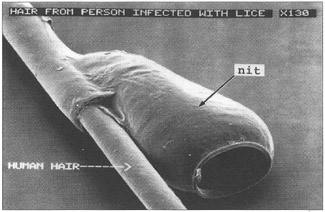
- Once laid, it takes 7-10 days for a nit to hatch, and another 7-10 days for the female to mature and begin laying her own eggs.
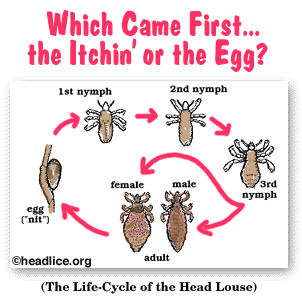 Head lice are clear in color when hatched, then quickly develop a reddish-brown color after feeding.
Head lice are clear in color when hatched, then quickly develop a reddish-brown color after feeding.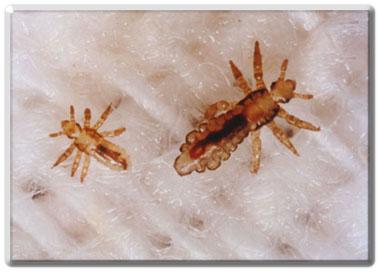 Head lice are about the size of sesame seeds.
Head lice are about the size of sesame seeds.- Head lice have six legs equipped with claws to grasp the hair.
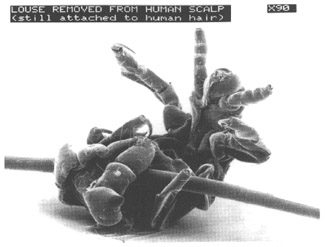 Head lice are crawling insects. They cannot hop, jump, or fly.
Head lice are crawling insects. They cannot hop, jump, or fly.- Head lice do not thrive on pets.
- Head lice are small, wingless insects which feed on human blood. They need human blood in order to survive.
- Head lice live for approximately 30 days on a host and a female louse may lay up to 100 nits (eggs).
- Head lice off of their human hosts will starve. The NPA suggests that, in most cases, a head louse will not survive for more than 24 hours off of its human host.
Look at this ugly little bastard
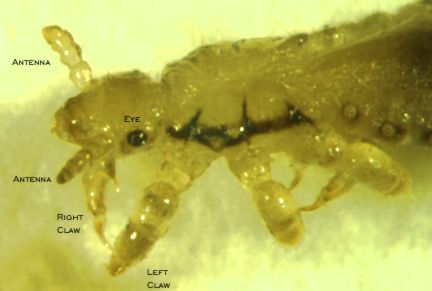
Know what to look for:
 The Treatment of Lice:
The Treatment of Lice:- Screening is crucial.
- Treating lice needs to be handled with caution. The best method is manual removal of nits.
- If you continue to be infested with live lice after treatment, discontinue use of the products and don't use other products in the hope of killing the lice. Remember, these products are not mere shampoos, cremes or lotions, they are pesticides.
- Never resort to dangerous remedies such as lindane, kerosene, or pet shampoos.
- Manual removal is crucial. Beyond snipping or pulling out the nits, you should also be screening for and removing live lice. Having at least two people check an infested person is important as one person cannot see the entire scalp. Lice move quickly and shy away from light when you are checking.
- Don't spend hours on end cleaning your environment. Head lice need human blood to survive. Vacuum surface areas only. Save your time and energy for what will benefit you most, delousing the individual. NEVER USE A LICE SPRAY!
- When screening for lice with a nit-removal comb, it may be helpful to dip it into water and clean it before going to the next section of hair.
- Equip yourself and your helpers with a magnifying glass, tweezers, safety scissors, and a nit-removal comb.
- If you are experiencing treatment failure, please report it to the NPA's Registry by clicking here.
To help with this screening process, the NPA has developed a medical device called the LiceMeister® Comb. Used on clean, damp and untangled hair, the comb is passed through the entire head of hair. If lice and nits are present, they will be collected by the comb. If you are not sure if it's lice or nits on the comb, refer to the Detection section.
Select stores are participating in the ALL OUT COMB OUT by carrying the LiceMeister Comb®. You can also order the comb directly from the NPA. Proceeds go to support the NPA's programs of research, education and prevention.The LiceMeister® Comb is to be used on clean, damp and untangled hair. If hair is shoulder length or longer, divide and section off the hair with clips. Then, section by section, comb through the entire head. If lice or nits are detected, then grasp a one-inch section of hair at a time and place the comb against the scalp, pulling it completely through the hair from the root to the end.

Clean the comb under running water, or dip it into a cup of water between passings to remove lice and nits from the comb. Hold it up to the light to ensure that it's completely clean before the next stroke. If hair is fine, you may want to apply inexpensive styling gel to assist with the removal of nits during the combing process.
When lice and nits are present, hair should be combed at least twice daily and, if shoulder length or longer, pulled back and up in a braid or bun. This process should continue for 2 weeks after lice and nits are no longer found during the combing process. After this, you can resume routine screening by combing twice weekly.
You need only one comb per household because the LiceMeister comb can be safely boiled if desired, whereas other combs may not live up to this claim.
No Nit Policy
Most important thing I learned from my research:
Remember, all lice-killing products are Pesticides. If you choose to purchase an over-the-counter treatment, follow the directions carefully and use with caution. The NPA strongly discourages prescription treatments containing lindane. Based on increasing reports of possible insect resistance on a national level, the NPA advises parents to discontinue their use at the earliest sign of treatment failure. MANUAL REMOVAL IS THE BEST OPTION WHENEVER POSSIBLE AND ESPECIALLY WHEN TREATMENT PRODUCTS HAVE FAILED.
A must read before treating: Jesse's Project!!! A mother's story her son.
[source]
[source]

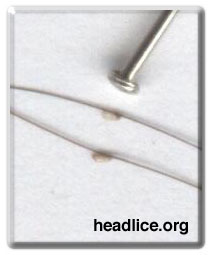
You did Good Maria... Very informative! I am a Pediatric Nurse.. and I worked in a Spec. Ed Center in NY for a few Years. We had a NO Nits Policy.
ReplyDeleteIt was Halloween one year and I had sent this one little girl home for days. I finally sat and nit picked this kid myself. It was nasty, but I hated that the kid was missing so much school.
Lice are persistent... I can tell you that.. and they are becoming more resistant to treatment!
You are a Good teacher kiddo!!!
Leslie
LeslieVeg@msn.com
http://leslielovesveggies.blogspot.com/
Leslie,
ReplyDeleteThank you so much. I appreciate that. Hearing about lice this morning just gets me crazed. I want to remove my kids from the school every time I hear it.
The teacher today told me how toxic the treatment is which is started my research.
Thank God I did because honestly I probably would have done what my parents did, treat, treat. Before the shampoo they used gasoline. I remember standing outside under the hose while the poured gas on our head. The fumes hurt my throat and eyes. Then we were rinsed until we were freezing. That water was so damn cold.